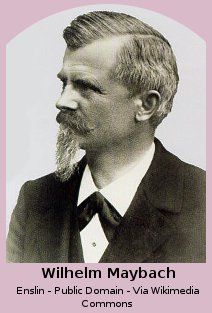Human Intelligence Must Comply With Nature
Before She Reveals Her Secrets
Part 24 - Part 23
Accurate thinking Prerequisite
Demonstrating his acute understanding of Human intelligence,
clear Thinker Nicolaus August Otto appears to be the first Inventor to
depart from basing Gas Engine design on Steam Engine parameters. Steam
engines belong to the field of Thermodynamics, but that is where the
relationship with the Internal Combustion Engine ends.
Nikolaus
appreciated the fact that the Internal Combustion Engine was a different
technology that demanded different principles be followed. That is, to
allow it to work, different Laws of Nature needed to be implemented.
Otto comprehended, as Beau de Rochas
so clearly suggested, that all elements of successful combustion take
place in the one cylinder. Including compression of gases before
ignition. A major point of misconception between the spirited pioneers
of this new source of motive power.
True Human Intelligence Is Rigorous Thought
From Theory to physical reality is no mean feat. This difficult process, every bit as much as conceiving the original idea, entails that most important aspect of all.
That aspect is Rigorous Thought.
Rigorous Thought is essential for productive, precise employment of Human Intelligence. No other thing can take it's place.

In the fourteen years following the dictates of Beau de Rochas, Otto
appears to be the only participant who grasped that Beau de Rochas's
formula offered the correct combination of Natural Laws permitting the
Internal Combustion process to function. And in an economical,
controllable manner that produced power.
A combination that lends itself to development and refinement.
It
has been suggested that Otto did not understand the crucial
relationship between compression of the gases before ignition, and fuel
economy. - Power output is also influenced by compression.
Otto had indicated in an earlier Patent application for improvements to his older Free Piston Engine, that he believed economy and power balanced on controlled rapid expansion of the gases.
This perhaps can be interpreted to mean he was aware of the pivotal impact of compression on power output, and was including compression of the fuel gas in his perceptions. In other words, he did understand the underlying Natural Law.
A Certain Price Must Be Paid
While Otto incorporated all the principles and suggestions of Beau de Rochas in his new engine, in his patent he emphasizes the importance of his concept of Stratification, being the provision of gas and air injected into the cylinder in discrete, controllable layers.

He describes in some detail a method whereby the Combustion Process
can be best controlled by affecting the rate of burn of these layers.
Otto was right on the money with his concept of gradual and smooth, but rapid combustion.
He
was nevertheless, mistaken with his method of execution. That error
shouldn't interpreted as a reflection of his capabilities. He simply
needed more time to apply rigorous Thought.
To emphasize this point, brilliant minds are still fine tuning the concept of efficient Combustion today.
Nature
always demands that a certain price is to be paid, by dedicated
practitioners of Human Intelligence, before parting with Her Secrets.
Dedicated practitioners totally understand this demand, and comply
willingly.
Nikolaus Otto proved the Beau de Rochas hypothesis
in Practice, and could justifiably stamp his mark on it, as the Otto
Cycle. Both these men have earned recognition for an outstanding
contribution to Humanities material progress.
Once again Otto trumped his Industry and led the Market, producing a capable alternative to the iron grip of Steam.
Unlike
most other manufacturers of Internal Combustion Engines, whose,
although inferior, offerings were imaginatively used in attempts to
power vehicles of all description, Otto and Langen concentrated on
stationary power-plants. The demand for which was so great they could
not keep up with.
Slew Of Opportunities
Nikolaus Otto's lucid understanding of Human intelligence generated an abundance of opportunities for other Great Minds to pursue.

Former employees of Otto, Gottlieb Daimler, (1834-1900) an Engineer and
Otto's technical director, and Wilhelm Maybach, (1846-1929) also an
Engineer, with whom Daimler created a Company, built a compact version
of Otto's engine and then developed it to suit an automobile.
This
entailed the use of Gasoline as a fuel, which needed to be vaporized,
requiring the invention of the Carburettor. Coal gas was the major fuel
source for engines of the period.
Petroleum products had been in
existence for some time and some engines did indeed consume gasoline.
But this potentially effective fuel too, presented a serious drawback.
Solution
Gasoline required a practical way to atomize it from a liquid to a vapor like spray and mix it with air, in specific proportions.
Several
imaginative renderings of an Atomizer, or Carburettor, as this
instrument came to be known, appeared towards the late 1800s. Notably,
English Engineer, Frederick Lanchester's Wick type, and Austrian
Engineer, Siegfried Marcus's Rotating Brush model.

However, it was Wilhelm Maybach's Float Feed, Spray Nozzle
carburettor which delivered a constant, controllable supply of correctly
mixed, atomized fuel that was the most advanced.
Maybach's
device subsequently proved to be suitable for any Internal Combustion
Engine and became the basis for the Industry Standard.
Agile minded Maybach had been working on atomization for some time.
It
was Maybach and Daimler's innovative pioneering work on practical
atomization, and the Otto cycle engine, in compact form, that laid the
foundations for the Automotive Industry.
Prominent amongst the
cascade of useful ideas flowing through these Great Minds, both Otto and
Daimler had the foresight to fit an engine to a bicycle. Creating the
forerunner of the modern Motorcycle.
Human Intelligence is now on the move, and will shortly be mobile in the Physical, as well as the Spiritual dimension.
Human Intelligence Rocks!
Part 24 - Part 23
Next - One More Peek





